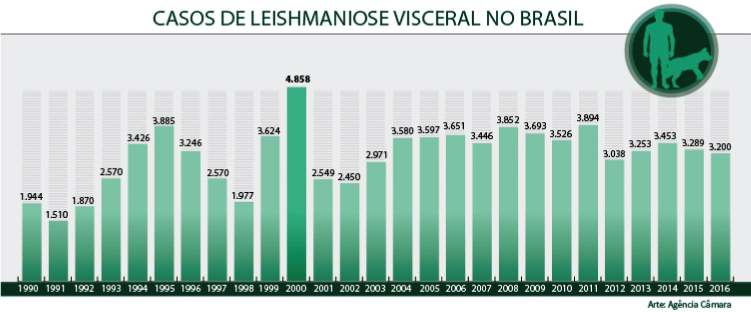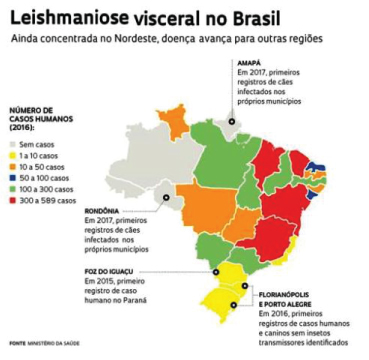
Bill that makes canine Visceral leishmaniasis vaccination free and obligatory advances
Proposition was approved by the Commission of Agriculture, Livestock, Food Supply and Rural Development of the National Congress’ Lower House in December
04/02/2019
The project has a conclusive nature and will still be analyzed by the Commissions of Finances and Taxes, Constitution and Justice and Citizenship
One of the most commonly used strategies in the fight against Visceral Leishmaniasis is the sacrifice of seropositive dogs considered infected, as well as reservoirs of the parasite (Leishmania infantum), but this control method has not been effective. Meanwhile, the disease progresses through Brazil and the population still suffers with sick animals and the difficulty being treated. As an attempt to change this scenario, the Commission of Agriculture, Livestock, Food Supply and Rural Development, at the Lower House in the Brazilian National Congress approved unanimously on December 12, 2018, a proposition that intends to make annual vaccination against leishmaniasis obligatory in all the Country, as it happens with the vaccine against rabies. The bill, approved as a substitute text, provides for the establishment of a National Policy on Vaccination against Canine Visceral Leishmaniasis as a form of prevention. The work would be developed in an integrated and joint manner between the organs of the Union, the states, the Federal District and the municipalities. The project is being carried out conclusively and will still be analyzed by the Committees of Finance and Taxation; Constitution and Justice; and Citizenship. Find the draft of Bill 1738/2011.
 Professor of Clinical Parasitology at the Federal University of Ouro Preto (UFOP), Alexandre Barbosa Reis, understands that this Law Project portrays the anxiety of the population from endemic areas when considering that the disease is reemerging in several regions of Brazil and emerging in others; some regions have registered between 30% and 40% infection rate among the canine population, a fact that scares residents. I can see the population understands that if there is a vaccine or vaccines available, why not protect their animals? he says. To him, the bill is a claim of the population for the government to do something beyond what is already being done in terms of disease control and prophylaxis, preventing it from spreading even further throughout the country.
Professor of Clinical Parasitology at the Federal University of Ouro Preto (UFOP), Alexandre Barbosa Reis, understands that this Law Project portrays the anxiety of the population from endemic areas when considering that the disease is reemerging in several regions of Brazil and emerging in others; some regions have registered between 30% and 40% infection rate among the canine population, a fact that scares residents. I can see the population understands that if there is a vaccine or vaccines available, why not protect their animals? he says. To him, the bill is a claim of the population for the government to do something beyond what is already being done in terms of disease control and prophylaxis, preventing it from spreading even further throughout the country.
However, Dr. Reis alerts for the gaps in the vaccines so far available in the market. We, the vaccine experts and parasitologists, looked at this process with caution, since we had two vaccines in Brazil, one of which was withdrawn from the market because it did not meet the requirements of the Ministry of Health (Phase 3 study), and the other that is kept on the market for individual dog vaccination. However, none of these two have so far demonstrated data on the actual reduction of human cases or whether they will also contribute to the reduction of infection to the vector, considering the dog is a reservoir. Regarding the vaccines available in the European market, the professor explains that they were not yet introduced in Brazil and for this to happen, they will need to go through all the regulatory and normative processes of the Ministry of Health and the Ministry of Agriculture, Livestock and Food Supply (MAPA). Finally, the researcher admits not knowing which vaccine the Brazilian government will acquire to be included in a vaccination campaign. But if any of them does pass to the control program, this will already represent a recognition of the effort made by researchers in the area, whether Brazilian or foreign, who have dedicated for the last decades to create these vaccines, he concludes.
Asked to clarify several points of the Brazilian Society of Tropical Medicine (BSTM), the Ministry of Health responded through an official notice that The Bill of Law nº1738/11 that regulates the National Policy of Animal Vaccination against Leishmaniasis, is still under analysis in the National Congress Lower House, within the commissions. After its approval in the House, it will be considered in the Federal Senate and only then, if approved by the National Congress, will be issued for presidential sanction. The Ministry of Agriculture, Livestock and Food Supply informed that the agency only supervises production and approves the vaccine.
While the bill remains in the pipeline, several key questions remain unanswered, such as: Was the study that demonstrated the efficacy or efficacy of the vaccine conducted in an experimental setting, with a known strain and in animals with a healthy immune system? How will the dogs be diagnosed? In mass vaccination campaigns? Only with serology? Will the pre-vaccine test be available as well? As it is known, the diagnosis is not complete with a single examination. How to ensure that the dog is free from disease only with a quick test? What about false positive? Will the government be able to hand 3 doses every 21 days on these dogs? Should not insecticidal collars also be recommended? There will be investment in castration programs; care for the environment, cleaning and sanitation; population awareness? Programs involving partnership between zoonotic diseases centers and City Councils? Are you aware that the available vaccine does not prevent the dog from becoming infected and does not block the transmission of the infected dog to the transmitting insect, so the cycle of transmission of the disease can continue to exist even with vaccination? What to do?
Trying to clarify several points, for example, whether the vaccine will be applied to dogs which are not entirely healthy, the epidemiologist and professor at Rio de Janeiro Federal University (UFRJ), Dr. Guilherme Werneck, as well as Dr. Reis, remembers that it is not known which of the vaccines will be implemented in this program, but so far only one is registered for use in Brazil. This vaccine has side effects, even in unhealthy dogs. These effects can reach up to 10% to 15% of dogs and range from local reactions (such as pain) to general or systemic reactions (apathy and lack of appetite), he says. Dr. Werneck adds that studies have showed that the chance of infection is diminished with vaccination, but not eliminated. I.e., the vaccine will not totally prevent a dog from being infected and developing the disease. Thus, these vaccines are said to be primarily clinically effective, that is, they reduce the severity of the disease in the dog allowing most of them to remain without symptoms of the disease even when they have acquired the infection.
So, if the available vaccine does not prevent the dog from becoming infected and does not block the transmission of the parasitized dog to the sandfly, what to do to prevent the cycle from continuing with the vaccination? To Dr. Werneck this is the fundamental question to be considered when recommending a vaccine or any other preventive measure for use in public health. The vaccines for Canine Visceral Leishmaniasis developed or under development in Brazil represent a great effort of a number of eminent researchers to find a solution to this serious health problem, but the results obtained so far do not justify these vaccines being inserted in large-scale programs as a public health measure. They are useful primarily for the dogs individual protection and should be recommended by veterinarians considering each particular situation, he said.
To him, in order to interrupt the transmission cycle, it is necessary to use, in an integrated manner, a series of measures, ranging from strategies aimed at insect and infected dogs’ populations control, including urban cleaning, environmental sanitation and housing improvements, to policies for the strengthening of surveillance and health care actions within the Unified Health System (SUS) and reducing poverty and social inequalities.
Visceral leishmaniasis increasingly common in urban centers
The picture behind the disease, whose prevention frequently results in animal sacrifice, includes issues related to social vulnerability, migrations, irregular occupation of forest areas and environment and climate changes. According to the article A parasite reaches the metropolis, diagnosis difficulty and warmer weather facilitate the progress of Visceral Leishmaniasis towards large urban centers. According to the study, kala-azar, previously restricted to the rural area and the Northeast region, now advances to cities such as Florianópolis (SC) and Porto Alegre (RS), which recorded the first cases in humans in 2017. Still according to the publication, in São Paulo, since 1999, when the municipalities of Araçatuba and Birigui, in the northwest region, registered the first cases in humans, VL has been spreading towards the coast. Of the 645 municipalities in São Paulo, 177 have already registered the disease among dogs or people.
 A study published in the journal PLOS Neglected Tropical Diseases Risk analysis and prediction of visceral leishmaniasis dispersion in São Paulo State, Brazil warns that by 2020 the number of infected dogs should increase in Balbinos, Sabino and Guaimbê (central region of São Paulo), due to the proximity to the Marechal Rondon highway, the high temperature and the occurrence of transmitting insects. The number of infected people should increase in Luiziânia, Alto Alegre and Santhopolis do Aguapeí, also to West, due to the increase of humidity and the coexistence of infected insects and dogs.
A study published in the journal PLOS Neglected Tropical Diseases Risk analysis and prediction of visceral leishmaniasis dispersion in São Paulo State, Brazil warns that by 2020 the number of infected dogs should increase in Balbinos, Sabino and Guaimbê (central region of São Paulo), due to the proximity to the Marechal Rondon highway, the high temperature and the occurrence of transmitting insects. The number of infected people should increase in Luiziânia, Alto Alegre and Santhopolis do Aguapeí, also to West, due to the increase of humidity and the coexistence of infected insects and dogs.
Another severe problem faced in the country is the lack of official data on leishmaniasis in most municipalities. According to experts, there are, on average, 200 infected animals for each recorded human case.
Neglected diseases
Numbers from the World Health organization (WHO) estimate that annually there are 2 million leishmaniasis cases worldwide. Brazil is among the five countries who hold 90% of all cases, along with Bangladesh, India, Nepal and Sudan. The Country also responds for 90% of all CVL in Latin America.
According to data from the Drugs for Neglected Diseases Initiative (DNDi), of the 850 treatment products approved worldwide between 2000 and 2011, only 4% were indicated to treat neglected diseases, accounting for 1% of all chemicals developed by the pharmaceutical industry. The numbers show little interest in developing effective and specific drugs against leishmaniasis and other neglected diseases.
…










